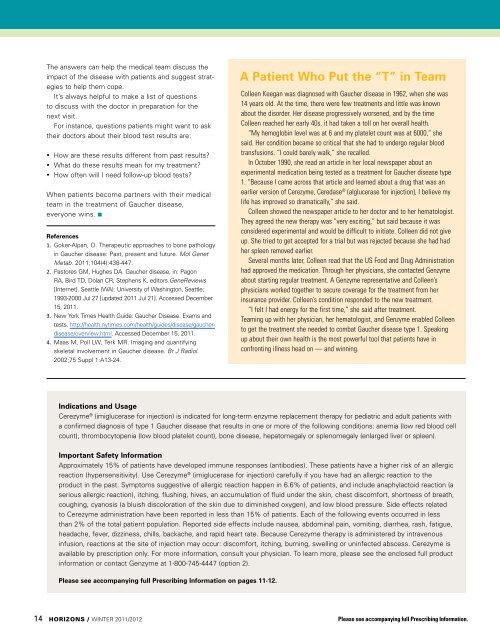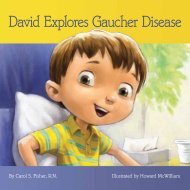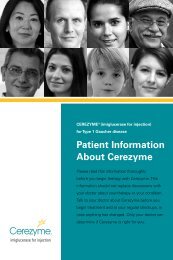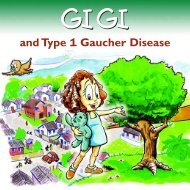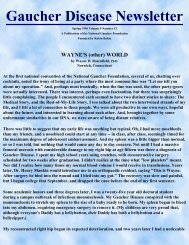Horizons Issue 3 2011 - National Gaucher Foundation
Horizons Issue 3 2011 - National Gaucher Foundation
Horizons Issue 3 2011 - National Gaucher Foundation
Create successful ePaper yourself
Turn your PDF publications into a flip-book with our unique Google optimized e-Paper software.
The answers can help the medical team discuss the<br />
impact of the disease with patients and suggest strategies<br />
to help them cope.<br />
It’s always helpful to make a list of questions<br />
to discuss with the doctor in preparation for the<br />
next visit.<br />
For instance, questions patients might want to ask<br />
their doctors about their blood test results are:<br />
• How are these results different from past results<br />
• What do these results mean for my treatment<br />
• How often will I need follow-up blood tests<br />
When patients become partners with their medical<br />
team in the treatment of <strong>Gaucher</strong> disease,<br />
everyone wins.<br />
References<br />
1. Goker-Alpan, O. Therapeutic approaches to bone pathology<br />
in <strong>Gaucher</strong> disease: Past, present and future. Mol Genet<br />
Metab. <strong>2011</strong>;104(4):438-447.<br />
2. Pastores GM, Hughes DA. <strong>Gaucher</strong> disease, in: Pagon<br />
RA, Bird TD, Dolan CR, Stephens K, editors.GeneReviews<br />
[Internet]. Seattle (WA): University of Washington, Seattle;<br />
1993-2000 Jul 27 [updated <strong>2011</strong> Jul 21]. Accessed December<br />
15, <strong>2011</strong>.<br />
3. New York Times Health Guide: <strong>Gaucher</strong> Disease. Exams and<br />
tests. http://health.nytimes.com/health/guides/disease/gaucherdisease/overview.html.<br />
Accessed December 15, <strong>2011</strong>.<br />
4. Maas M, Poll LW, Terk MR. Imaging and quantifying<br />
skeletal involvement in <strong>Gaucher</strong> disease. Br J Radiol.<br />
2002;75 Suppl 1:A13-24.<br />
A Patient Who Put the “T” in Team<br />
Colleen Keegan was diagnosed with <strong>Gaucher</strong> disease in 1962, when she was<br />
14 years old. At the time, there were few treatments and little was known<br />
about the disorder. Her disease progressively worsened, and by the time<br />
Colleen reached her early 40s, it had taken a toll on her overall health.<br />
“My hemoglobin level was at 6 and my platelet count was at 6000,” she<br />
said. Her condition became so critical that she had to undergo regular blood<br />
transfusions. “I could barely walk,” she recalled.<br />
In October 1990, she read an article in her local newspaper about an<br />
experimental medication being tested as a treatment for <strong>Gaucher</strong> disease type<br />
1. “Because I came across that article and learned about a drug that was an<br />
earlier version of Cerezyme, Ceredase ® (alglucerase for injection), I believe my<br />
life has improved so dramatically,” she said.<br />
Colleen showed the newspaper article to her doctor and to her hematologist.<br />
They agreed the new therapy was “very exciting,” but said because it was<br />
considered experimental and would be difficult to initiate. Colleen did not give<br />
up. She tried to get accepted for a trial but was rejected because she had had<br />
her spleen removed earlier.<br />
Several months later, Colleen read that the US Food and Drug Administration<br />
had approved the medication. Through her physicians, she contacted Genzyme<br />
about starting regular treatment. A Genzyme representative and Colleen’s<br />
physicians worked together to secure coverage for the treatment from her<br />
insurance provider. Colleen’s condition responded to the new treatment.<br />
“I felt I had energy for the first time,” she said after treatment.<br />
Teaming up with her physician, her hematologist, and Genzyme enabled Colleen<br />
to get the treatment she needed to combat <strong>Gaucher</strong> disease type 1. Speaking<br />
up about their own health is the most powerful tool that patients have in<br />
confronting illness head on — and winning.<br />
Indications and Usage<br />
Cerezyme ® (imiglucerase for injection) is indicated for long-term enzyme replacement therapy for pediatric and adult patients with<br />
a confirmed diagnosis of type 1 <strong>Gaucher</strong> disease that results in one or more of the following conditions: anemia (low red blood cell<br />
count), thrombocytopenia (low blood platelet count), bone disease, hepatomegaly or splenomegaly (enlarged liver or spleen).<br />
Important Safety Information<br />
Approximately 15% of patients have developed immune responses (antibodies). These patients have a higher risk of an allergic<br />
reaction (hypersensitivity). Use Cerezyme ® (imiglucerase for injection) carefully if you have had an allergic reaction to the<br />
product in the past. Symptoms suggestive of allergic reaction happen in 6.6% of patients, and include anaphylactoid reaction (a<br />
serious allergic reaction), itching, flushing, hives, an accumulation of fluid under the skin, chest discomfort, shortness of breath,<br />
coughing, cyanosis (a bluish discoloration of the skin due to diminished oxygen), and low blood pressure. Side effects related<br />
to Cerezyme administration have been reported in less than 15% of patients. Each of the following events occurred in less<br />
than 2% of the total patient population. Reported side effects include nausea, abdominal pain, vomiting, diarrhea, rash, fatigue,<br />
headache, fever, dizziness, chills, backache, and rapid heart rate. Because Cerezyme therapy is administered by intravenous<br />
infusion, reactions at the site of injection may occur: discomfort, itching, burning, swelling or uninfected abscess. Cerezyme is<br />
available by prescription only. For more information, consult your physician. To learn more, please see the enclosed full product<br />
information or contact Genzyme at 1-800-745-4447 (option 2).<br />
Please see accompanying full Prescribing Information on pages 11-12.<br />
14 <strong>Horizons</strong> / Winter <strong>2011</strong>/2012 Please see accompanying full Prescribing Information.


